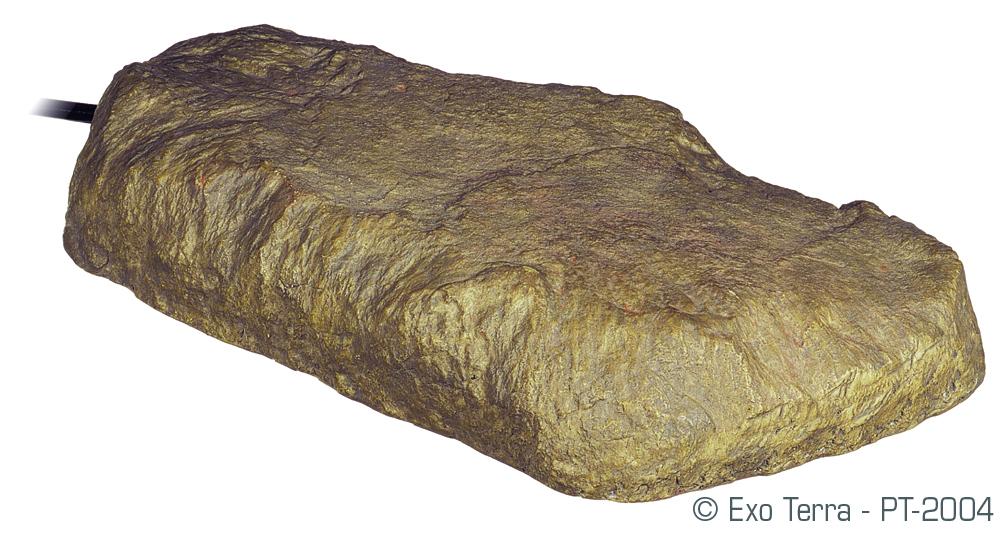You’ve probably heard it screamed all over the reptile forums: “DON’T BUY HEAT ROCKS!” But this can be confusing for new reptile owners — after all, if heat rocks are so bad, why would they be manufactured by major brands and recommended by pet store employees?
Could it be that an unfair bias has formed against heat rocks over the years? Are overcautious reptile owners exaggerating the risks of an otherwise legitimate way to help your reptile stay warm? After all, reptiles sit on warm rocks all the time in the wild, so how could an electric heat rock be a problem in your reptile’s enclosure?
It turns out that heat rocks are exactly as dangerous as everyone claims, and today we’re going to help you understand why.
First, how do reptiles thermoregulate?
Reptiles are often referred to as “cold-blooded” or “ectothermic,” but to be more specific, reptiles are poikilotherms. This means that they are capable of controlling their body temperature, but instead of using internal means to do so like birds and mammals, they strategically split their time between warm and cool areas to maintain their desired body temperature. The “ideal” reptile body temperature varies widely, depending on species, current metabolic needs, and health status. For example, a bearded dragon prefers a higher basking temperature than a veiled chameleon, and a corn snake that is digesting a meal is likely to keep itself warmer than one with an empty stomach.
In the wild, reptiles get their heat from one source: the sun. Whether they’re basking in a patch of sunlight during the day, or they’re stretched out on a patch of asphalt after sundown, they are ultimately directly or indirectly dependent on the sun for the warmth that they need to “charge” their internal “battery.”
Reptiles that bask during the day receive Infrared-A and -B wavelengths from sunlight, which are powerful forms of heat energy that penetrate deeply into reptile tissue and efficiently warm them from the inside out. Reptiles that get their heat from sun-warmed dens or rocks receive Infrared-C radiant heat energy, which is the weakest form of infrared. This means that it takes them longer to harvest the amount of heat energy that they need, but the reptiles dependent on this method of “basking” are usually smaller and/or have a lower heat needs compared to their day-basking counterparts.
So why are heat rocks bad?
Heat rocks “trick” reptiles into thinking that they’re still cold even when they’re being burned. Here’s how it works:
Heat rocks are designed to convert electrical energy into heat that radiates from the rock’s surface. This heat is the same Infrared-C heat that we were just talking about: weak, inefficient, and unable to penetrate past a reptile’s skin. This means that when a reptile lays on top of a heat rock, the heat collects in the animal’s skin and it’s up to the bloodstream to deliver that heat to the rest of the reptile’s body before the area in contact with the heat rock starts to overheat.
Here’s the problem: For reptiles, body temperature dictates metabolic rate. When they have a high body temperature, their heart beats fast. When they have a low body temperature, their heart beats slowly. So if the air is too cool and the reptile’s metabolism is sluggish, that means its blood is circulating sluggishly too. Because heat rocks only warm a reptile’s belly and not its whole body (the thermoreceptors related to helping a reptile sense its body temperature are primarily located in the spine), being exposed to the heat being produced by the heat rock doesn’t increase its metabolism fast enough. So the blood can’t carry heat away from the reptile’s belly fast enough, which results in more and more heat accumulating in that area until eventually the flesh starts to burn!
Why can’t reptiles sense that they’re being burned by the heat rock?
Reptiles sense temperatures differently than humans do. While they are able to sense and react to sudden changes in temperature, such as touching a very hot or cold object, they aren’t very good at sensing that the surface that they’re laying on is slowly getting hotter. Even when their own flesh starts to burn from the heat, if the reptile’s brain is still telling it that its body hasn’t reached the right temperature yet, then even though the reptile may be in pain, it’s unlikely to remove itself from the device.
Reptiles evolved to either receive heat from above or collect it from a gradually-cooling surface underneath them. Their bodies are not equipped to gather heat by sitting on a small, consistently hot surface while the air around them is relatively cool.
Is there any way to make heat rocks safe to use?
To put it briefly, no.
Is a flat stone placed beneath a halogen flood heat lamp safe? Yes.
Is a large heat mat connected to a thermostat and placed over or under a warm hide safe? Yes.
But heat rocks are not safe. If you have a heat rock, the best thing you can do with it is remove its cord and use it as a naturalistic decoration.











